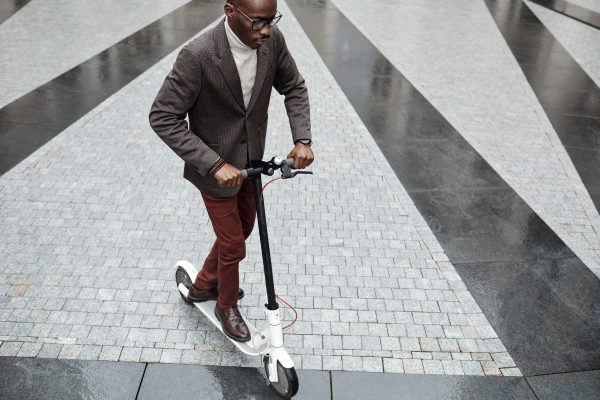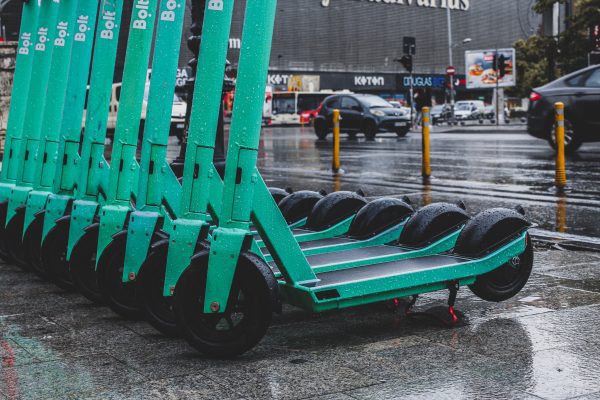As we embrace the golden years of life, maintaining independence, comfort, and a fulfilling lifestyle becomes paramount. Mobility challenges need not hinder our ability to explore, connect, and enjoy life to the fullest. In this article, we delve into the art of selecting the perfect mobility scooter for seniors. We unravel the intricate factors that demand careful consideration when choosing a scooter, emphasizing not only safety and practicality but also the profound impact that a thoughtfully chosen scooter can have on a senior’s overall well-being. Join us as we explore how the right mobility scooter becomes a conduit to freedom, confidence, and an enriched quality of life.

Key Takeaways
- Prioritize seat comfort for extended rides and reduced fatigue.
- Consider stability and balance features for safe and secure operation.
- Select a scooter with an appropriate weight capacity to ensure safety and performance.
- Evaluate portability options for convenient transportation and storage.
- Look for safety features such as lights, brakes, and stability systems.
- Conduct a test drive to assess comfort, handling, and user-friendliness.
- Seek professional consultation for tailored recommendations and safety considerations.
- Set a budget that balances affordability with essential features and long-term benefits.
- Ultimately, the right mobility scooter enhances independence, comfort, and overall quality of life for seniors.
Selecting A Scooter For A Senior
Choosing a scooter carefully for a senior is crucial for their safety, comfort, and quality of life. A well-chosen scooter enhances their independence, prevents isolation, and promotes physical activity. It also reduces the risk of accidents, eases mobility challenges, and contributes to their emotional well-being. By meeting specific needs and preferences, the right two-wheeled vehicle ensures dignity, confidence, and a higher level of daily engagement while lessening the burden on caregivers. It’s an investment in their overall health and happiness.
Choosing a scooter for a senior requires careful consideration to ensure their safety, comfort, and ease of use. Here are some factors to keep in mind when selecting a two-wheeler for a senior:
Type Of Scooter
When considering mobility scooters for seniors, there are two primary types to select from: three-wheeled scooters and four-wheeled scooters. Each type has its own advantages and considerations.
- Three-Wheeled Scooters: Three-wheeled are designed with one wheel in the front and two wheels in the back. They are known for their maneuverability and are ideal for indoor use and navigating through tight spaces. These vehicles have a smaller turning radius, making them perfect for indoor environments like homes, malls, and grocery stores. However, they might have slightly less stability compared to four-wheeled, which could be a consideration if the senior plans to use the scooter primarily outdoors or on uneven terrain.
- Four-Wheeled Scooters: Four-wheelers offer enhanced stability and are better suited for outdoor use. They provide a smoother ride on various terrains, including sidewalks, parks, and even some light off-road paths. These vehicle typically have larger and wider frames, providing a more comfortable and stable platform. While they might have a larger turning radius than three-wheelers, their stability makes them a safer choice for seniors who want to explore outdoor spaces.
Ultimately, the choice between a three-wheeled and a four-wheeled vehicle depends on the senior’s specific needs and preferences. If indoor maneuverability is a priority, a three-wheeler might be the better choice. On the other hand, if the senior plans to spend more time outdoors or on uneven surfaces, a four-wheeler could offer a smoother and more stable experience. It’s important to consider factors such as where the vehicle will be primarily used, the senior’s comfort, and any physical limitations they might have when making this decision.
Stability And Balance
Ensuring stability and balance is paramount when choosing a mobility scooter for a senior. These factors are pivotal in guaranteeing the user’s safety and comfort, particularly for those facing mobility or balance challenges. A stable two-wheeled vehicle reduces the risk of tipping, creating a secure platform for navigation. Look for wider wheelbases, low centers of gravity, and anti-tip wheels to enhance stability. Comfortable, adjustable seats and handlebars contribute to maintaining balance, with the type of terrain also impacting the choice between three-wheeled and four-wheelers. Practical testing, expert consultation, and personal feedback are invaluable in determining the scooter that provides optimal balance and stability, ensuring a smooth and secure riding experience for the senior.
Weight Capacity
Weight capacity stands as a pivotal factor when deliberating on a mobility scooter for a senior. This capacity signifies the maximum weight the two-wheeled vehicle can safely bear, encompassing both the user’s weight and any carried items. Prioritizing an appropriate weight capacity is imperative for safety, guaranteeing stability and avert potential accidents or tipping risks. Opting for a scooter that aligns its weight capacity with the user’s weight not only enhances safety but also optimizes performance and durability, while ensuring a comfortable and steady ride. Taking into account additional accessories or belongings carried on the scooter further underscores the significance of choosing a suitable weight capacity. By meticulously matching the scooter’s weight capacity to the user’s needs, a secure, comfortable, and reliable mode of mobility is assured for the senior.
Seat Comfort
Seat comfort is a vital aspect to consider when choosing a mobility scooter for a senior. The quality of the seat directly impacts the user’s comfort, especially during extended rides. Here’s why prioritizing seat comfort is crucial:
- Longer Rides: Seniors often use mobility scooters for various activities, such as shopping, outdoor excursions, or visiting friends. A comfortable seat minimizes discomfort or strain during longer rides, ensuring a more enjoyable experience.
- Reduced Fatigue: A well-padded and supportive seat reduces the risk of fatigue and discomfort, allowing the senior to stay active for longer periods without feeling tired or sore.
- Posture Support: The seat should provide proper support for the back, hips, and legs. Adequate cushioning and ergonomic design promote healthy posture, preventing discomfort or pain from poor seating positions.
- Adjustability: Opt for a two-wheeled vehicle with an adjustable seat, allowing the senior to find the most comfortable position. An adjustable seat height can also help ensure that the senior’s feet comfortably touch the ground when seated.
- Material Quality: High-quality, durable upholstery materials contribute to seat comfort and longevity. Look for materials that are both comfortable and easy to clean.
- Suspension: Some two-wheelers come with suspension systems that absorb shocks from uneven terrain, enhancing overall ride comfort by minimizing jolts and vibrations.
- Armrests and Seat Width: Depending on the senior’s needs, consider the presence of armrests and the seat width. Armrests can provide additional support, while a suitable seat width ensures comfort without feeling too confined.
- Personal Preferences: Everyone has unique preferences for seat comfort. Involve the senior in the decision-making process, allowing them to test different scooters and select the one with the most comfortable seat.
- Test Rides: Whenever possible, encourage the senior to test the two-wheeler by taking it for a short ride. This hands-on experience helps gauge the actual comfort level of the seat.
By prioritizing seat comfort, you’re ensuring that the senior can confidently and comfortably enjoy their mobility scooter, making daily activities more pleasant and maintaining their overall well-being.
Adjustable Handlebars And Tiller
Opting for a mobility scooter with adjustable handlebars and tiller is a strategic choice when considering the needs of a senior user. These customizable features contribute significantly to the user’s comfort and ease of operation. Here’s why adjustable handlebars and tiller are important:
- Personalized Ergonomics: Seniors have varying comfort preferences and physical requirements. Adjustable handlebars and tiller allow the user to customize the height and angle of the controls to suit their specific needs, promoting a more natural and comfortable riding posture.
- Reduced Strain: Properly adjusted handlebars and tiller prevent unnecessary strain on the arms, shoulders, and wrists. Seniors can find the optimal position that minimizes discomfort and fatigue during rides.
- Easy Reach: Customizable controls ensure that the senior can comfortably reach and operate the handlebars without overextending or leaning too far. This ease of reach enhances control and maneuverability.
- Safety: The ability to adjust handlebars and tiller helps ensure that the senior maintains proper control over the two-wheeler, contributing to safe navigation, especially in various environments.
- Adaptable Use: Adjustable controls accommodate users of different heights and body types, making the vehicle suitable for a range of individuals if shared among family members or caregivers.
- Transfer Accessibility: Adjustable handlebars and tiller can facilitate easy entry and exit from the two-wheeler, particularly for seniors with limited mobility.
- Personal Preference: Involve the senior in the adjustment process to ensure their preferences are met. This sense of control enhances the overall user experience.
- Health Conditions: Seniors with specific health conditions, such as arthritis or joint stiffness, can benefit from the ability to set the controls to a position that minimizes discomfort.
When selecting a mobility scooter, prioritize models that offer adjustable handlebars and tiller. By providing the senior with the means to fine-tune these features, you’re enhancing their overall comfort, control, and safety, ensuring a more enjoyable and user-friendly experience.
Battery Life And Range
Considering a mobility scooter for a senior involves assessing battery life and range, which are crucial for maintaining their independence and mobility. Longer battery life allows extended usage without frequent charging, enabling outdoor exploration and daily tasks. Adequate range ensures safe and convenient travel, while considering factors like terrain and charging accessibility is important. By selecting a two-wheeler that meets these criteria, seniors can confidently navigate their surroundings and engage in activities without worrying about power limitations.
Maneuverability

Maneuverability is a vital consideration when selecting a mobility scooter for seniors. It pertains to the two-wheeler’s agility in tight spaces and around obstacles. A maneuverable two-wheeler is essential for indoor use, crowded areas, and negotiating turns with ease. The turning radius and wheel configuration impact this trait, influencing the two-wheeler’s ability to navigate both indoor and outdoor environments. Prioritizing maneuverability ensures that the senior can move effortlessly and safely, enhancing their mobility and overall experience with the vehicle.
Portability
Portability stands as a crucial consideration in the selection of a mobility scooter for seniors. This aspect encompasses the two-wheeler’s ease of transport and storage, directly influencing its practicality and adaptability. A portable scooter, capable of being disassembled or folded, holds immense value for seniors who seek convenience during travel. Whether for journeys by car or plane, a portable two-wheeler offers seamless transportation. Furthermore, its compact storage footprint accommodates limited spaces in homes or apartments. This attribute not only fosters independence but also empowers seniors to explore diverse environments and socialize without relying on assistance. By prioritizing a user-friendly design and manageable weight, the senior gains the ability to assemble and transport the scooter comfortably, ensuring their mobility remains unhindered and adaptable to various circumstances.
Controls
Controls constitute a crucial aspect in the selection of a mobility scooter for seniors, as they serve as the interface for operating the vehicle. The usability and safety of controls are paramount, allowing seniors to navigate the two-wheeler effectively. User-friendly controls ensure a seamless experience, facilitating confident and intuitive operation without confusion. Positioned for accessibility, these controls contribute to safe and accurate maneuvering. Visible indicators and well-lit displays enhance visibility, ensuring seniors can monitor the scooter’s status even in varying lighting conditions. By prioritizing simplicity, ergonomic design, and emergency features, the two-wheeler’s controls become a reliable and user-centric component of the overall mobility experience for seniors.
Safety Features
Safety features hold paramount importance in the selection of a mobility scooter for seniors, as they significantly contribute to the user’s overall well-being and security while operating the two-wheeler. These features address crucial aspects of safety, starting with fall prevention mechanisms like anti-tip wheels and stability systems that prevent accidents caused by balance issues. Enhanced visibility through headlights, taillights, and reflectors reduces the risk of collisions, especially in low-light conditions. Reliable braking systems ensure quick stops and control, while a horn alerts others to the senior’s presence, enhancing safety in crowded spaces. Seat belts offer security during uneven rides, and adjustable speed controls enable the senior to maintain a comfortable and safe pace. By choosing a two-wheeler equipped with these comprehensive safety measures, the senior can confidently navigate their environment while enjoying both comfort and peace of mind.
Warranty And Service
Considering warranty and service options holds significant importance in the process of choosing a mobility scooter for seniors. These aspects are pivotal in ensuring the two-wheeler’s reliability and long-term performance. A manufacturer’s warranty not only provides assurance of the two-wheeler’s quality but also safeguards against potential defects or malfunctions. It covers repair or replacement costs within a designated timeframe, relieving the senior of financial concerns. Access to authorized service centers ensures prompt repairs and maintenance, further enhancing the scooter’s dependability. Additionally, technical support and extended warranty options contribute to a comprehensive package of assistance. By prioritizing warranty and service considerations, the senior gains a durable and well-supported mobility solution that is both reliable and backed by the manufacturer’s commitment to their satisfaction.
Test Drive
Conducting a test drive is an essential step when selecting a mobility scooter for seniors. This hands-on experience provides valuable insights into the two-wheeler’s performance, comfort, and suitability. Here’s why a test drive matters:
- Comfort Assessment: A test drive allows the senior to assess the two-wheeler’s comfort firsthand, including the seat, legroom, and overall ergonomics. This ensures a comfortable and enjoyable riding experience.
- Handling and Maneuverability: Testing the two-wheeler’s maneuverability, turning radius, and responsiveness provides a feel for how it handles in different environments, whether indoors or outdoors.
- Ease of Use: A test drive allows the senior to interact with the controls, ensuring they are user-friendly and easy to operate, promoting independence and confidence.
- Stability: By experiencing the two-wheeler’s stability during the test drive, the senior can evaluate its balance and safety features, crucial for preventing accidents.
- Terrain Compatibility: If possible, test the two-wheeler on various terrains to gauge its performance and comfort on different surfaces.
- Physical Comfort: Assess how the vehicle accommodates any physical limitations the senior may have, such as joint pain or reduced mobility.
- Personal Preference: A test drive provides an opportunity to confirm if the two-wheeler aligns with the senior’s personal preferences and needs.
- Expert Advice: Seek guidance from experts or sales representatives during the test drive to address any questions or concerns the senior might have.
- Confidence Boost: A successful test drive instills confidence in the senior’s ability to operate the two-wheeler, encouraging them to use it more frequently.
- Comparison: If considering multiple two-wheelers, test driving each allows for direct comparisons, aiding in making an informed decision.
Prioritizing a test drive ensures that the mobility scooter chosen is a good fit for the senior’s comfort and requirements. By experiencing the two-wheeler firsthand, the senior gains valuable insights that contribute to a well-informed and confident decision.
Consult A Professional
Seeking professional consultation holds paramount importance when selecting a mobility scooter for seniors. The expertise of professionals, such as occupational therapists or mobility specialists, is invaluable in tailoring the two-wheeler choice to the senior’s specific needs and circumstances. By assessing individual mobility challenges and medical considerations, these professionals can recommend a scooter that prioritizes safety, comfort, and functionality. Their guidance ensures that the scooter aligns seamlessly with the senior’s physical condition, enabling them to navigate with confidence and ease. Moreover, seeking professional advice validates the choice, fostering a sense of assurance and satisfaction for the senior. Ultimately, this consultation contributes to a well-informed decision that optimizes the scooter’s benefits and positively impacts the senior’s overall mobility and well-being.
Budget
Taking budget into account holds fundamental significance when choosing a mobility scooter for seniors. This financial parameter serves as a guiding factor, influencing the selection process to align with the senior’s affordability. By setting a budget, one ensures that the chosen scooter remains within reasonable financial bounds, preventing overspending. Evaluating different scooter models in relation to the budget enables a well-informed decision that balances essential features with cost. Additionally, accounting for potential ancillary expenses like accessories, maintenance, and warranties offers a comprehensive understanding of the overall investment. While being budget-conscious, it’s essential to also recognize the long-term value the scooter brings to the senior’s daily life and independence. By conducting comparative assessments and exploring financing options if necessary, one can secure a mobility scooter that caters to the senior’s needs while upholding financial prudence.
Remember that each senior’s needs and preferences may differ, so it’s important to involve them in the decision-making process and prioritize their comfort and safety.

Conclusion
Choosing the right mobility scooter for seniors requires a thoughtful and comprehensive approach, considering various factors that impact their comfort, safety, and overall quality of life. By prioritizing aspects such as seat comfort, stability and balance, weight capacity, portability, safety features, and more, you can tailor the selection to the specific needs and preferences of the senior. Furthermore, engaging in a test drive, seeking professional advice, and factoring in budget constraints ensure a well-informed decision that promotes mobility, independence, and well-being. The careful consideration of these elements empowers seniors to confidently navigate their surroundings, maintain an active lifestyle, and enjoy the freedom that a well-suited mobility scooter provides.
